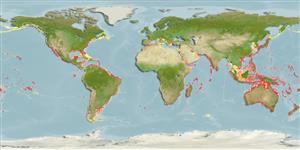Common names from other countries
Environment: milieu / climate zone / depth range / distribution range
Ecologia
; intervalo de profundidade 0 - 50 m (Ref. 7727). Tropical
Circumglobal tropical, temperate seas and the Mediterranean Sea.
Length at first maturity / Tamanho / Peso / Idade
Maturity: Lm ? range ? - ? cm Max length : 19.0 cm TL macho/indeterminado; (Ref. 126605); Peso máx. publicado: 41.00 g (Ref. 126605); Idade máx. registada: 1.00 anos (Ref. 126605)
Sea hares have annual life cycles (Ref. 126605). Found roaming around various species of algae. A nocturnal species (Ref. 822). Common in intertidal and subtidal habitats to about 5 m in depth. A specialized herbivore and feeds largely on red algae (Ref. 866). Known from depths of 0 to 50 m (Ref. 7727); and from intertidal rock pools, and immediate subtidal on alga-covered reefs (Ref. 337). Also on seagrass (Ref. 109264).
Life cycle and mating behavior
Maturidade | Reprodução | Desova | Ovos | Fecundidade | Larvas
Members of the order Anaspidea are mostly simultaneous hermaphrodites.
Burn, R. 2006. (Ref. 7727)
Categoria na Lista Vermelha da IUCN (Ref. 130435)
Categoria CITES (Ref. 108899)
Not Evaluated
Not Evaluated
Utilização humana
| FishSource |
Ferramentas
Mais informação
Idade/Tamanho
Crescimento
Comprimento-peso
Comprimento-comprimento
Morfologia
Larvas
Abundância
Fontes da internet
Estimates based on models
Preferred temperature
(Ref.
115969): 15.3 - 28.8, mean 26.7 (based on 1728 cells).
Vulnerabilidade
Low vulnerability (10 of 100).
Categoria de preço
Unknown.
